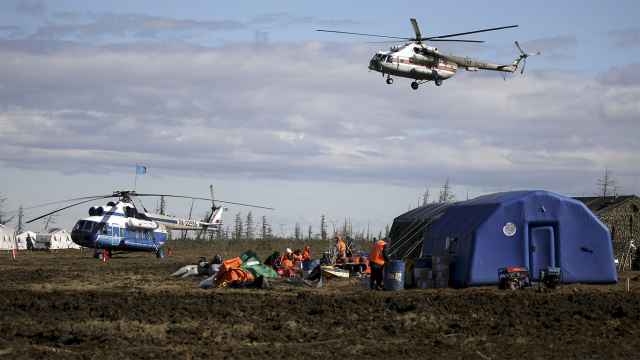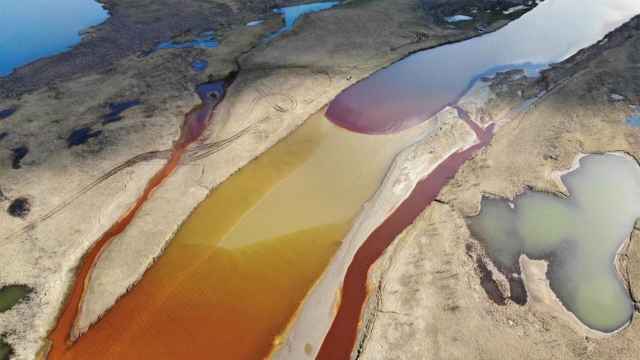As climate change accelerates, the once distant and frozen Arctic is transforming into a controversial industrial frontier. Nowhere is this tension clearer than along Russia’s Northern Sea Route (NSR). This emerging shipping corridor, running along Russia’s 6,000-kilometer Arctic coastline, is being touted by the Kremlin as a lucrative shortcut between Europe and Asia.
But as we illustrate in our new report, the rush to exploit this fragile environment threatens to turn the Arctic into another zone of sacrifice — one where delicate ecosystems are collateral damage in the hunt for hydrocarbons and geopolitical influence.
The Arctic is in a vicious cycle where the melting sea ice that makes the NSR more accessible jeopardizes the region’s unique biodiversity and climate stability. Russia’s ambitions to transform this route into a major trade artery — and to ramp up oil and gas extraction along its coastline — risk compounding the climate crisis while leaving Arctic ecosystems vulnerable to catastrophic pollution.
In 2024 alone, more than 84% of the cargo transported along the NSR was oil and gas. Fossil fuel extraction is the engine driving Russia’s Arctic strategy. The Kremlin shows no sign of slowing down, even amid its ongoing war in Ukraine and mounting international sanctions.
Moscow envisions the NSR not only as an export lifeline but as a geopolitical lever, a tool to project power and reshape global shipping routes. Moscow promotes it as a faster, cheaper alternative to the Suez Canal, with a growing fleet of icebreakers ensuring year-round navigation.
But this industrialized vision collides with a stark reality. The NSR remains a treacherous route subject to rapidly shifting ice conditions, dangerous ice ridges, and narrow, shallow straits. Even in summer, migrating ice floes can choke critical passages, while thick fogs and sudden storms add another layer of risk. In winter, the entire route freezes solid, navigable only with the help of powerful icebreakers.
The infrastructure needed to manage emergencies like oil spills and other vessel accidents is practically nonexistent. Ships stuck in ice might wait weeks for assistance, and specialized equipment for cleaning oil spills in Arctic conditions is in critically short supply.
Yet Russia’s push to develop the NSR continues, driven by powerful economic incentives. As global demand for oil and gas persists, the Arctic shelf represents a trove of untapped resources. Extracting these resources demands more than just drilling platforms; it requires the construction of coastal infrastructure, ice-class tankers, and an extensive support network — all of which increase the risk of pollution and environmental degradation.
Russia’s plans also involve a growing shadow fleet of older, lightly regulated oil tankers that operate outside normal maritime insurance and safety frameworks. In 2024, at least seven such vessels were spotted along the NSR. These ships often sail with their transponders turned off, are poorly maintained, and operate virtually free of any oversight. Were an accident to occur — such as an oil spill — response times could stretch into weeks, if a response comes at all.
Even beyond the threat of unmanageable oil spills, intensive shipping threatens the Arctic in subtler but no less damaging ways. Noise pollution from ship engines disrupts the lives of mammals like whales and seals, whose communication and navigation depend on sound. Ballast water discharges can introduce invasive species, undermining the delicate balance of Arctic marine life. And increased traffic means more greenhouse gas emissions, accelerating the very climate change that is already melting the ice and opening these waters.
Russia’s regulatory framework offers little reassurance. Despite strategic documents that nod to environmental protection, there are no binding targets for reducing shipping’s negative impacts. The International Maritime Organization has banned the use and carriage of heavy fuel oil (HFO) in the Arctic as of 2024 — a necessary step given HFO’s high risk of spills and its production of black carbon and sulfur oxides that worsen both climate change and local air quality. Yet Russia has refused to join the ban, allowing its ships to continue burning one of the dirtiest fuels available in the world’s most fragile environment.
Adding to the threat is the legacy of nuclear contamination along Russia’s Arctic coast. Decades of Soviet-era nuclear vessels, reactors, and sunken nuclear submarines haunt the seabed, while active military nuclear facilities dot the coastline. International cooperation on cleanup projects has stalled since the invasion of Ukraine began, leaving these radioactive risks largely unaddressed.
Russia’s Arctic coastline spans half of the entire Arctic Ocean — a vast and fragile habitat for fish, marine mammals, and migratory birds. This region is not just a domestic matter; it is a global concern. Yet Russia’s environmental stewardship has lagged far behind its economic ambitions.
To understand how Russia’s Arctic strategy evolved, it helps to look back in time. The idea of using the NSR as a transport link between Europe and Asia was first proposed in 1525 by Russian diplomat Dmitry Gerasimov. But it was not until 1878–79 that the Swedish explorer Baron Nils Nordenskjöld finally navigated the route, emerging through the Bering Strait into the Pacific. In 1932, the Soviet icebreaker Alexander Sibiryakov became the first vessel to complete the entire NSR in a single navigation season, marking the route’s modern birth.
The first true transport operation took place two years later, in 1935. But it was only in the 1970s and 1980s — thanks to the creation of the Soviet nuclear icebreaker fleet — that the NSR began to see sustained use. The Norilsk Mining and Metallurgical Plant on the far northern Taimyr Peninsula, with its year-round cargo demands, helped drive this industrial expansion. Today, as climate change reshapes the Arctic, Moscow sees a chance to fulfill its centuries-old ambition of making the NSR not just a seasonal route but a permanent fixture of global trade.
But at what cost? Russia’s 2022 Maritime Doctrine names the Arctic seas, the NSR and the continental shelf as key national priorities that are critical to the nation’s economy and security. Environmental and climate concerns are acknowledged, but are always a secondary consideration. The priority is clear: open the Arctic, extract its resources, and cement Russia’s geopolitical dominance of the entire region.
If the international community fails to challenge this approach, the Arctic could become yet another environmental casualty of unchecked industrial ambition. We have already witnessed how fragile ecosystems can collapse under the weight of pollution and climate disruption. The world cannot afford to let the Arctic — one of our last, almost unspoiled frontiers — become a sacrifice zone for fossil fuels and power politics.
This means governments must take action. Third-country governments in particular should discourage the use of the NSR by avoiding cooperation with Chinese or other companies seeking to employ it as a transit corridor. Last year, we issued an open letter to Norway’s Prime Minister urging his government to reject such involvement. This year, with reports of a Chinese company planning shipments via the NSR to Rotterdam, Hamburg, and Gdansk, we are preparing open letters to those ports and relevant authorities.
At the same time, the international community must closely monitor the shadow fleet carrying Russian oil through the NSR. Sanctions should be imposed not only on these vessels but also on companies that service them or buy their oil, including through secondary sanctions.
By treating the NSR as a dangerous and illegitimate trade corridor, and by targeting those who profit from it, we can help ensure that the Arctic is preserved rather than sacrificed to short-term economic and geopolitical gain.
A Message from The Moscow Times:
Dear readers,
We are facing unprecedented challenges. Russia's Prosecutor General's Office has designated The Moscow Times as an "undesirable" organization, criminalizing our work and putting our staff at risk of prosecution. This follows our earlier unjust labeling as a "foreign agent."
These actions are direct attempts to silence independent journalism in Russia. The authorities claim our work "discredits the decisions of the Russian leadership." We see things differently: we strive to provide accurate, unbiased reporting on Russia.
We, the journalists of The Moscow Times, refuse to be silenced. But to continue our work, we need your help.
Your support, no matter how small, makes a world of difference. If you can, please support us monthly starting from just $2. It's quick to set up, and every contribution makes a significant impact.
By supporting The Moscow Times, you're defending open, independent journalism in the face of repression. Thank you for standing with us.
Remind me later.






